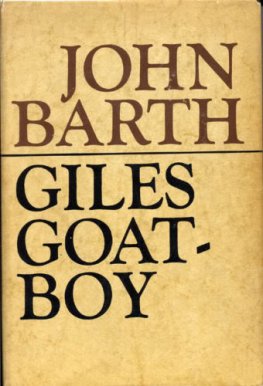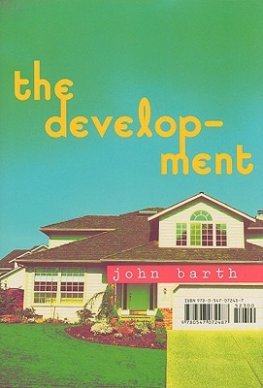The Development
John Barth
Houghton Mifflin Company
BOSTON NEW YORK
2008
BOOKS BY JOHN BARTH
THE FLOATING OPERA
THE END OF THE ROAD
THE SOT-WEED FACTOR
GILES GOAT-BOY
LOST IN THE FUNHOUSE: FICTION FOR
PRINT, TAPE, LIVE VOICE
CHIMERA
LETTERS
SABBATICAL: A ROMANCE
THE FRIDAY BOOK:
ESSAYS AND OTHER NONFICTION
THE TIDEWATER TALES: A NOVEL
THE LAST VOYAGE OF SOMEBODY THE SAILOR
ONCE UPON A TIME: A FLOATING OPERA
FURTHER FRIDAYS: ESSAYS, LECTURES,
AND OTHER NONFICTION, 19841994
ON WITH THE STORY
COMING SOON!!!
THE BOOK OF TEN NIGHTS AND A NIGHT:
ELEVEN STORIES
WHERE THREE ROADS MEET
THE DEVELOPMENT: NINE STORIES
Copyright 2008 by John Barth
All rights reserved
For information about permission to reproduce selections
from this book, write to Permissions, Houghton Mifflin Company,
215 Park Avenue South, New York, New York 10003.
www.houghtonmifflinbooks.com
Library of Congress Cataloging-in-Publication Data
Barth, John, date.
The development : nine stories / John Barth.
p. cm.
ISBN 978-0-547-07248-7
I. Title.
PS 3552 .A 75 D 48 2008
813'.54dc22 2008011092
Book design by Melissa Lotfy
Printed in the United States of America
DOC 10 9 8 7 6 5 4 3 2 1
This book is a work of fiction. Names, characters, and incidents portrayed in it are the product of the author's imagination or are used fictitiously. The author's use of names of actual places or persons living or dead is incidental to the purposes of the plot and not intended to change the entirely fictional character of the work.
Earlier versions of stories in this book first appeared in the following periodicals: "Peeping Tom" and "Assisted Living" in Subtropics, Winter/Spring 2006 and Fall 2007; "The Bard Award" in Zoetrope 10:1, Spring 2006; "Toga Party" in Fiction 20:1, 2006 (reprinted in The Best American Short Stories 2007); "Teardown" in Conjunctions 47, 2006; "Progressive Dinner" in New Letters 73:2, 2007; "The End" in Mississippi Review 35:31, 2007; "Us/Them" in The Hopkins Review 1.2, Spring 2008. My thanks to Jin Auh and her knowledgeable associates at The Wylie Agency for arranging these initial publications as well as their collection in the present volume; also to Jane Rosenman and Larry Cooper of Houghton Mifflin for seeing this volume through the press. And thanks most of all to my wife, the book's dedicatee, for (among much else) her unerringly on-the-mark editorial suggestions.
For Shelly
Contents
Peeping Tom 1
Toga Party 25
Teardown 56
The Bard Award 73
Progressive Dinner 94
Us/Them 116
Assisted Living 130
The End 141
Rebeginning 154
Peeping Tom
D ON'T ASK ME (as my wife half teasingly did earlier this morning) who I think is reading or hearing this. My projected history of our Oyster Cove community, and specifically the season of it's Peeping Tom, is barely past the note-gathering stage, and there's nobody here in my study at 1010 Oyster Cove Court except me and my PC, who spend an hour or three together after breakfast and morning stretchies before Margie and I move on to the routine chores and diversions of a comfortably retired American couple in the dawn of the new millennium and the evening of their lives. Maybe our CIA/FBI types have found ways to eavesdrop on any citizen's scribbling? Or maybe some super-shrewd hacker has turned himself into a Listening Tom, the electronic equivalent of Oyster Cove's peeper, even when I'm talking to myself?
Don't ask me (but in that case you wouldn't need to, right?); I just work here. For all I know, "You"like the subject of this history, in some folks' opinionmay not actually, physically exist. Unlike him, however (and we all assume our P.T., whether real or imagined, to have been a Him, not a Her), you're an invited guest, who- and whatever You are, not an eavesdropper. Welcome aboard, mate, and listen up!
As I was saying, I just work here, more or less between nine and noon most mornings, while Margaret the Indispensable does her ex-businesswoman business in her own workspace upstairs: reviews and adjusts our stock-and-bond accounts and other assets; pays the family bills and balances our checkbook; works the phone to line up service people; schedules our errands and appointments; plans our meals, vacation trips, grandkid visits ... and Next Big Moves.
Which last-mentioned item prompts this whatever-it-is-I'm-doing. Margie and I have pretty much decided (and she'll soon e-mail the news to our middle-aged offspring, who'll be Sad But Relieved to hear it) that what with my ominously increasing memory problems and her near-laming arthritis, the time has come for us to list this pleasant "villa" of ours with a realtor and get ready to get ready to shift across and down the river from good old Heron Bay Estates (of which more presently) to TCI's assisted-living establishment, Bayview Manor.
Even Margiea professional real-estate agent herself back in our city-house/country-house days, when she worked the suburban D.C. residential market while I taught history to fifth-and sixth-formers at Calvert Heights Country Day Schooleven Margie rolls her Chesapeake-green, macularly degenerating eyes at all that developers' lingo. Heron Bay Estates, now approaching the quarter-century mark, was the first large gated-community project of Tidewater Communities, Inc.: a couple thousand acres of former corn and soybean fields, creeper-clogged pine woods, and tidewater wetlands on Maryland's river-veined Eastern Shore. By no means "estates" in any conventional sense of that term, our well-planned and "ecologically sensitive" residential development is subdivided into neighborhoodssome additionally gated, most notwith names like Shad Run and Egret's Crest (low-rise condominiums), Blue Crab Bight (waterfront "coach homes," the developer's euphemism for over-and-under duplexes, with small-boat dockage on the adjacent tidal creek), Rockfish Reach (more of a stretch than a reach, as the only water in sight of that pleasant clutch of mid- to upper-midrange detached houses is a winding tidal creeklet and a water-hazard pond, ringed with cattails, between the tenth and eleventh holes of HBE's golf course, whose Ecological Sensitivity consists of using recycled "gray water" on it's greens and fairways instead of pumping down the water table even further), Spartina Pointe (a couple dozen upscale McMansions, not unhandsome, whose obvious newness so belies the fake-vintage spelling of their reeded land-spit that we mockingly sound it's terminal e: "Spartina Pointey," or "Ye Oldey Spartina Pointey")and our own Oyster Cove, whose twenty-odd "villas" (on a circular "court" around a landscaped central green with a fountain that spritzes recycled water three seasons of the year) have nothing of the Mediterranean or Floridian that that term implies: In the glossary of HBE and of TCI generally, "villas" are side-by-side two-story duplexes (as distinct from those afore-mentioned "coach homes" on the one hand and detached houses on the other) of first-floor brick and second-floor vinyl clapboard siding, attractively though non-functionally window-shuttered, two-car-garaged, and modestly porched fore and aft, their exterior maintenance and small-lot landscaping managed mainly by our Neighborhood Association rather than by the individual owners. Halfway houses, one might say, between the condos and the detached-house communities.
Indeed, that term applies in several respects. Although a few of us are younger and quite a few of us older but still able, your typical Oyster Cove couple are about halfway between their busy professional peak and their approaching retirement. Most would describe themselves as upper-middle-incomersan O.C. villa is decidedly











